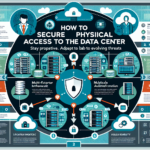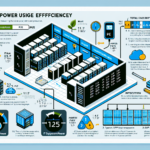Implementing a fire suppression system in a datacenter is critical to ensuring the safety of personnel, protecting sensitive equipment, and minimizing downtime. Here are the best practices and strategies for implementing fire suppression systems in datacenters:
1. Understand Fire Risks in Datacenters
Datacenters present unique fire risks due to high concentrations of electrical equipment, heat generation, and cabling. Fires can start from overloaded circuits, faulty components, or even human error. A tailored solution should account for these risks.
2. Choose the Right Fire Suppression System
There are several types of fire suppression systems suitable for datacenters. Each has pros and cons depending on the environment, size, and budget:
a. Clean Agent Systems
- Gas-Based Suppression: Uses inert gases (e.g., argon, nitrogen) or halocarbon agents (e.g., FM-200, Novec 1230) to extinguish fires without damaging sensitive electronics.
- Advantages: Safe for equipment, leaves no residue, and ideal for enclosed spaces.
- Considerations: Requires proper room sealing and regular maintenance.
b. Pre-Action Sprinkler Systems
- Water-based fire suppression where water is only released upon fire detection and confirmation.
- Advantages: Reliable and cost-effective.
- Considerations: Risk of water damage if deployed incorrectly.
c. Water Mist Systems
- Uses fine mist to suppress fires while minimizing water damage.
- Advantages: Effective for cooling and reducing heat while being less damaging than traditional sprinkler systems.
d. Inert Gas Systems
- Systems like Argonite and Inergen reduce oxygen levels to suppress fires while remaining safe for humans.
- Advantages: Non-corrosive, no residue, and protects delicate electronics.
e. Foam-Based Systems
- Uses chemical foam to suppress fires but is less common in datacenters due to potential residue issues.
3. Implement Advanced Detection Systems
Fire suppression systems are only effective when paired with reliable fire detection mechanisms. Ensure your datacenter includes:
– Smoke Detectors: Early warning systems to detect smoke particles.
– Heat Detectors: Identify abnormal temperature rises.
– Air Sampling Systems: Highly sensitive systems like VESDA (Very Early Smoke Detection Apparatus) that sample air for microscopic particles.
– Integrated Alarms: Alerts to notify personnel or trigger automated suppression.
4. Ensure Proper Room Sealing
For gas-based systems, it’s essential to have properly sealed rooms to ensure the gas remains effective. Conduct periodic integrity testing (e.g., door fan tests) to check for leaks.
5. Segmentation of Fire Suppression Zones
Divide the datacenter into zones based on risk levels, equipment density, or operational importance. This allows suppression systems to activate only in affected areas, minimizing disruption.
6. Redundant Systems
Implement redundant fire suppression systems to ensure reliability. A backup system can help mitigate risks if the primary system fails.
7. Regular Maintenance and Testing
- Perform routine inspections and testing of fire suppression systems to ensure proper operation.
- Replace expired clean agent chemicals and inspect for leaks or system malfunctions.
- Test alarms, detectors, and discharge mechanisms regularly.
8. Integrate with Monitoring Systems
Tie fire suppression systems into your datacenter’s monitoring and alerting platform. This ensures real-time updates to IT staff and building management systems.
9. Train Staff and Develop Protocols
- Train IT and maintenance staff on fire suppression system operation and evacuation procedures.
- Create clear protocols for fire detection, suppression activation, and post-fire recovery.
10. Follow Industry Standards
Adhere to standards such as:
– NFPA 75: Standard for the Protection of IT Equipment.
– NFPA 2001: Standard on Clean Agent Fire Extinguishing Systems.
– ISO/IEC 27002: Information security guidelines include physical security measures.
11. Deploy Backup Power for Suppression Systems
Ensure fire suppression systems are connected to backup power (UPS or generator) to remain operational during outages.
12. Plan for Water Damage Mitigation
If using water-based systems, ensure proper drainage and containment mechanisms to prevent equipment damage. Use raised floors and sealed racks to mitigate risks.
13. Perform Risk Assessments
Conduct regular fire risk assessments to identify vulnerabilities and optimize your suppression system accordingly.
By implementing these best practices, you can protect your datacenter infrastructure while ensuring business continuity in the event of a fire. Always consult with fire safety professionals and follow local regulations when designing or upgrading your system.




